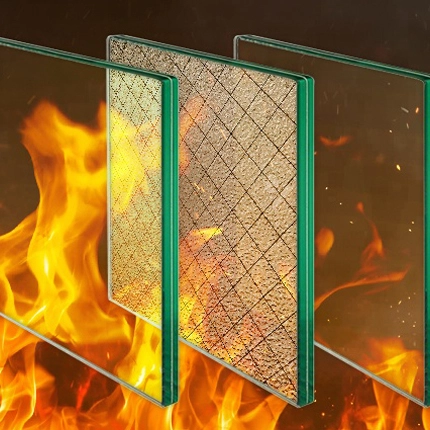
Fire-rated glass, also known as fire-resistant glass or fire-protective glass, is designed to withstand exposure to fire and heat, providing a barrier against the spread of flames, smoke, and radiant heat. This type of specialty window glass is used in buildings and structures to enhance fire safety and protect occupants by slowing down the progression of fire. Fire-rated glass is typically classified based on its ability to resist fire for a specified duration.
1. High Borosilicate fire rated glass
IM | Model | Thickenss | Weight | Transm ittance | Area limiation | Tolerance | Fire time min | ||
mm | kg/m2 | % | Min | Max | Thickness | Size | |||
High Borosilicate fire rated glass | EGF06 | 6 | 14.1 | 92 | 200X300 | 2100X3200 | +/-0.2 | +/-3 | 90-180 |
EGF08 | 8 | 18.8 | 92 | 200X300 | 2100X3200 | +/-0.3 | +/-3 | 90-180 | |
EGF10 | 10 | 23.5 | 91 | 200X300 | 2100X3200 | +/-0.3 | +/-3 | 90-180 | |
EGF12 | 12 | 28.2 | 91 | 200X300 | 2100X3200 | +/-0.3 | +/-3 | 90-180 | |
2. Monolithic GYL fire rated glass
Thickness (mm) | Fire Type function | Fire time (min) | Weight KG/SQ | Fire Temperature |
5 | Fire Integrity C0.5h, C1.0h, C1.5h | 30,60,90 | 12.5 | >1000 |
6 | Fire Integrity C0.5h, C1.0h, C1.5h | 30,60,90 | 15 | >1000 |
8 | Fire Integrity C0.5h, C1.0h, C1.5h | 30,60,90 | 20 | >1000 |
10 | Fire Integrity C0.5h, C1.0h, C1.5h, C2.0 | 30,60,90,120 | 25 | >1000 |
12 | Fire Integrity C0.5h, C1.0h, C1.5h, C2.0 | 30,60,90,120 | 30 | >1000 |
15 | Fire Integrity C0.5h, C1.0h, C1.5h | 30,60,90 | 37.5 | >1000 |
19 | Fire Integrity C0.5h, C1.0h, C1.5h | 30,60,90 | 47.5 | >1000 |
1.1 Integrity and Insulation: Fire-rated glass is characterized by its ability to maintain integrity (resistance to breakage) and insulation (resistance to heat transfer) during exposure to fire. This helps contain flames and limit the transmission of heat to the non-fire side.
1.2 Laminated Layers: Fire-rated glass often consists of multiple layers, including at least one layer of intumescent material. The intumescent layer swells when exposed to heat, forming a heat-resistant barrier that helps prevent the spread of fire.
1.3 Testing and Certification: Fire-rated glass products undergo rigorous testing according to recognized standards, such as those established by organizations like Underwriters Laboratories (UL) in the United States or the European Standard (EN) in Europe. The glass is classified based on its fire resistance duration, typically expressed in minutes.
1.4 Variety of Ratings: Fire-rated glass is available with various fire resistance ratings, such as 20 minutes, 30 minutes, 60 minutes, 90 minutes, and 120 minutes. The rating indicates the duration the glass can withstand exposure to fire while maintaining its integrity and insulation properties.
2.1 Fire-Rated Windows and Doors: Fire-rated glass is commonly used in windows and doors to create fire-rated openings in walls. This allows for visibility and access while maintaining fire compartmentation.
2.2 Fire-Resistant Partitions: Fire-rated glass is used in interior partitions to create fire-resistant barriers between different sections of a building. This helps prevent the spread of fire and smoke.
2.3 Fire-Protective Glazing: In areas where visibility is crucial, such as corridors or stairwells, fire-rated glass is used to provide fire protection without sacrificing transparency.
2.4 Fire-Rated Screens and Curtains: Fire-rated glass can be incorporated into screens or curtains to create movable fire barriers in open spaces.
2.5 Fire-Resistant Facades: Fire-rated glass may be used in the external facades of buildings to comply with fire safety regulations while maintaining an aesthetically pleasing design.
2.6 Emergency Exit Enclosures: Fire-rated glass is employed in emergency exit enclosures, providing occupants with a safe and visible route during a fire.
2.7 Skylights and Roof Glazing: Fire-rated glass can be used in skylights and roof glazing to maintain fire compartmentation in buildings with complex designs.
2.8 Laboratories and Industrial Settings: Fire-rated glass may be used in areas where fire protection is critical, such as laboratories or industrial facilities.
It's crucial to follow building codes and regulations when selecting and installing fire-rated glass to ensure that it meets the specific requirements for the intended application. Fire-rated glass is an essential component of a comprehensive fire protection strategy in buildings and structures.
Pls contact us if you have any inquire or questions, thank you.
No.12111, JINGSHI ROAD, LIXIA DIST, JINAN CITY, SHANDONG PROVINCE, CHINA